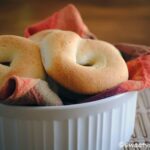Ingredients
Scale
- 2 cups (240g) cassava flour or cassava starch (Also known as tapioca, mandioca or yucca flour)
- 2 tbsp precooked corn meal or all purpose flour **See notes
- 1 tsp baking powder
- 2 tbsp sugar
- 1 tsp salt
- 2 cups (200g) queso fresco, grated
- ½ cup (50g) feta cheese, grated
- 3 tbsp butter (softened)
- 1 large egg
- Milk as needed
Instructions
- Pre-heat oven at 425ºF (220ºC).
- In a food processor add the cassava flour, precooked cornmeal, baking powder, sugar and salt. Pulse a few times to mix all the ingredients really well.
- Now add the queso fresco, feta cheese, butter, egg and mix a few more seconds to incorporate them with the dry mix. Then slowly add then milk until you get a soft dough.
- Form the dough into small balls (About the size of a golf ball) and place them on a cookie sheet lined with parchment paper. You can also roll out the ball to make a string about ½ inch (1 cm) thick and pinch the ends together to end up with a bagel shaped pandebono.
- Bake the pandebonos for about 20-25 minutes or until golden brown. Serve immediately.
Notes
- If using precooked cornmeal, make sure it is specifically made for making arepas. Otherwise, you can use all purpose flour.
- You can use 2½ cups of Colombian queso costeño instead of the queso fresco and feta cheese. You should also skip adding the salt since the queso costeño is pretty salty.
- The reason we’re using a food processor to mix all the ingredients is so the pandebonos don’t end up with a powdery coat on top after they’re baked. This usually happens when the cassava flour is not mixed thoroughly with the rest of the ingredients.
